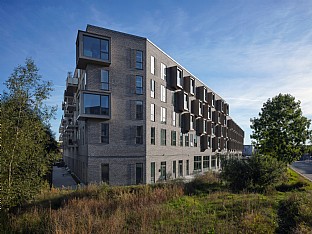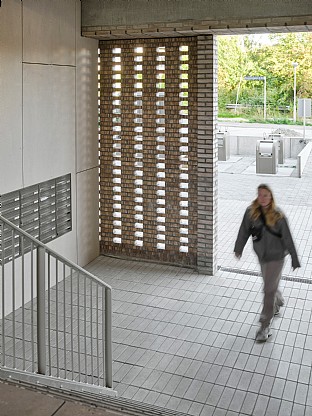Munkeengen i Hillerød er et bolig- og næringsbygg som fungerer som et bindeledd mellom den gamle bykjernen nær Frederiksborg slott og den nye bydelen Favrholm, som er under utvikling. Prosjektet støtter kommunens planer for området og oppfyller krav til sosialt mangfold og klimavennlige tiltak.
Bygget er et kvartal med 107 leiligheter i ulike størrelser for å skape en variert beboersammensetning, tre næringslokaler og parkering i to etasjer med innskutt dekke. Kvartalet er delt opp i flere bygningsvolumer med varierende høyder, som bryter ned den store skalaen. Fasaden kjennetegnes av mønstermurverk, karnapper og balkonger som skaper både variasjon og helhet. Første etasje har ekstra takhøyde for funksjoner som butikk, innganger mot gårdsrommet og sykkelparkering. Private soner langs fasaden gir beboerne mulighet til å trekke seg tilbake, mens butikkfasaden danner en aktiv sone og en ny urban forbindelse mot sentrum.
Holdbart og grønt
Gårdsrommet over parkeringsetasjen inviterer til mange former for fellesopphold og lek – fra sandkasser til sitteplasser og sansehager. Beboerne har også tilgang til to store takterrasser og omkringliggende grøntområder. Gården er delt i fire øyer forbundet av stier med benker og lekeapparater, utformet slik at de skaper ro og privatliv rundt terrassene.
Materialene er enkle og slitesterke. Fargene og teglfasaden reflekterer Hillerøds historiske byggestil, med rødbrune tegltoner. Vinduene og karnappene har brune nyanser, mens sokkelen har en mørkere farge. Belegningen i gårdsrommet består av tegl som harmonerer med fasadene.
Regnvann samles opp fra de grønne takene, og bygget sertifiseres med DGNB Gull.






